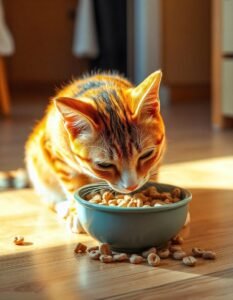
If you’ve ever come across hydrolyzed protein diets for pets and felt unsure about what they are, you’re not the only one! While the wide variety of cat food options available today is great for our feline friends, it can be a bit overwhelming for pet owners. Hydrolyzed diets are specifically designed for cats with food sensitivities or allergies, as the protein in these foods is broken down into smaller molecules through a process called hydrolysis.
What exactly are hydrolyzed protein cat foods?
Food provides essential nutrients that the body breaks down to support energy, growth, and overall development. Proteins, which are vital for various bodily functions and growth, play a crucial role in a balanced diet. Cats, being obligate carnivores, typically get their protein from animal or fish sources like chicken, beef, or salmon in commercial pet foods.
Traditional cat food contains intact protein molecules that the cat’s digestive system processes. However, in some cases, these proteins can trigger issues such as inflammatory responses or immune reactions in cats with food allergies or conditions like inflammatory bowel disease (IBD).
To address this, hydrolyzed protein pet foods are formulated by breaking down large protein molecules into smaller particles. This process alters the proteins so that the cat’s immune system does not recognize or react to them, offering a nourishing alternative that minimizes digestive or allergic disturbances.
What Are Hydrolyzed Diets Used For?

Commercial cat foods commonly derive their protein from sources like meat and fish.
In my role as a veterinarian, I typically recommend hydrolyzed protein diets in two key situations: when addressing food allergies or managing chronic inflammatory conditions of the gut.
When diagnosing gastrointestinal issues in cats, I place significant emphasis on diet as a critical component of a comprehensive treatment strategy. Recent research has shown promising outcomes with hydrolyzed diets for cats suffering from inflammatory bowel disease (IBD) and food allergies.
Dietary allergies
Cats with food allergies often experience an immune reaction to specific nutrients in their meals, typically certain proteins. Hydrolyzed diets modify these protein molecules enough to prevent the immune system from responding, thereby avoiding associated digestive issues.
These diets are also beneficial for cats with food sensitivities or intolerances, which involve adverse reactions to particular foods without triggering the immune system but still causing digestive discomfort. By addressing these dietary needs, hydrolyzed diets can help minimize symptoms like vomiting or diarrhea while meeting the nutritional requirements of the cat.
Chronic Digestive Conditions
Chronic gut inflammation, such as in cases of IBD, is believed to result from an abnormal immune reaction to specific foods. Diets with hydrolyzed proteins offer nutrients that are easier to digest, helping cats with compromised bowel function process their meals more effectively.
What are the signs that indicate my cat might require a specialized diet?
Chronic gastrointestinal issues and food intolerances in cats often present with similar symptoms. Additionally, food allergies may lead to skin-related problems. If you observe any changes in your cat’s skin, eating habits, digestion, or bathroom behavior, scheduling a veterinary appointment is highly recommended.
Key Benefits and Problems With Hydrolyzed Diets
Hydrolyzed protein cat foods are designed not only to minimize adverse immune reactions to common proteins but also to serve as a nutritionally balanced, long-term option for cats requiring such diets. These specialized formulas typically include easily digestible proteins and are enriched with omega-3 fatty acids, vitamins, minerals, essential amino acids, and antioxidants to promote immune health, digestion, and the maintenance of healthy skin and fur.
One challenge with these diets is that the hydrolysis process can sometimes affect their taste and texture, potentially making them less appealing to cats. However, advancements in research and product development have been improving the palatability of these diets, offering better options for cats that depend on them.
What is the process for transitioning my cat to a hydrolyzed protein diet?
Hydrolyzed protein cat food is designed for specific dietary needs and should only be introduced under a veterinarian’s guidance. These diets often require a prescription, and your vet can also determine if other cats in your home can safely eat the same food to avoid accidental consumption of non-hydrolyzed options.
If your veterinarian recommends this type of food, you might need to experiment with a few varieties to find the best fit for your cat. These diets are available in both wet and dry forms. When transitioning to a new food, it’s important to do so gradually over several days by mixing increasing amounts of the new food with the old one. This slow adjustment is particularly crucial for cats with sensitive stomachs. Keep an eye on your cat during this period for any signs of discomfort or a recurrence of symptoms.
Common Questions and Answers
Hydrolyzed protein can be beneficial for cats, particularly those dealing with food allergies or persistent digestive issues, as the protein is broken down into smaller components that are easier to process. Most cats, however, can handle regular proteins without difficulty and don’t need this specialized diet.
The higher cost of hydrolyzed protein cat food is due to the complex and advanced production methods involved. The process requires carefully selecting and breaking down protein molecules to prevent triggering immune responses in sensitive cats, which makes it more expensive to produce compared to standard cat food.
These diets typically require a veterinarian’s prescription since they are designed for specific medical conditions and should only be used under professional guidance.